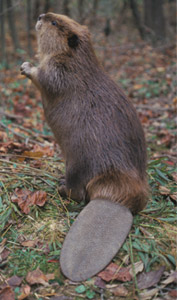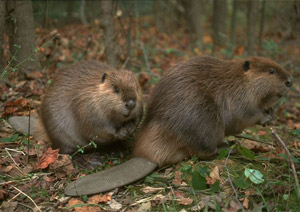Main Content
Article
Beaver
Beavers (Castor canadensis) were once rare in Indiana due to overharvest but are now abundant. In 1935, the Indiana Department of Conservation obtained a few breeding pairs from Wisconsin and released them on Jasper-Pulaski Fish & Wildlife Area. Beaver populations expanded, aided by strategic relocations to certain parts of the state to help with expansion. Presently, beavers are found in almost every county.
Are you a paddler interested in helping conserve and manage wildlife for future generations? Consider volunteering for the Paddlecraft Wildlife Index.
Similar species

General description
- The beaver is the largest rodent in North America.
- Most adults weigh between 30 and 70 pounds and measure about 4 feet long.
- Like other rodents, the beaver’s front teeth (incisors) grow throughout its life. The backs of their incisors are softer than the fronts so that when they gnaw, the teeth are constantly sharpened.
- The beaver's front feet are adept at digging, grooming and carrying objects.
- Their large hind feet are webbed for swimming.
- A unique feature is that the second toenail of each hind foot is double or split and is used as a comb to groom their fur.
- The distinctive flat beaver tail is used as a rudder and to propel the beaver while swimming. It also supports the body when cutting trees. When startled the beaver smacks its tail on the water, alerting others in the area of possible danger.
- Beavers dive under water to escape danger and can remain submerged for up to six minutes.
As ecosystem engineers, beaver are best known for cutting trees, building dams and adapting their environment to fit their needs. - Although all beavers are capable of building lodges, most in Indiana build a modified bank burrow with a couple tunnels that lead from below water level up into the bank to a nest chamber above water level.
Distribution and abundance
During the 1950s, the principal beaver range was the Kankakee River and Tippecanoe River drainage systems. Now, more than 8,000 miles of flowing water and thousands of acres of lakes and ponds in Indiana provide habitat for beavers.
Beavers have few predators except man. Because they live in small, isolated colonies and are intolerant of newcomers, disease spread is not common and has little effect on population growth. It is estimated that without the management afforded by regulated trapping and damage removal, the beaver population would increase by about one-third each year.
Reproduction
Beavers can start breeding at 2-years old, though most don’t reproduce until at least 3, especially females. Beavers generally mate in January or February and give birth 107 days later to 3 or 4 kits. Young are weaned between 6-weeks to 2-months old. Juveniles stay with their family groups through their second winter and help raise the next year’s kits. They disperse to find their own territory just before they turn 2. Beavers can disperse between 10 and 60 miles to find new territories.
Food Habits

Beavers are strict vegetarians.
Winter foods:
- Roots and rhizomes of water lilies.
- Bark and twigs of trees, especially willow and aspen, and other woody plants. Before winter arrives, beaver fell trees, clip branches from the main log, and then stash them in piles under water. When ice covers the water surface, food is readily available by swimming from the lodge to the brush pile.
Spring and summer foods:
- Leafy parts and roots of aquatic plants, including cattails, duck potatoes, water lilies, spatterdock, grasses and sedges.
- Willow leaves and twigs.
- Beavers are also very fond of young blackberry canes, and when cornfields are nearby, corn may also be eaten.
Management and control
Most beaver harvest is in response to abundant beaver populations and attempts by landowners to remove nuisance beavers during the legal season. At present, the owner or tenant of any property may take beaver discovered damaging property without a permit during the closed season. If you do not want to trap the beaver yourself, contact a licensed nuisance wild animal control operator.
A beaver dam is not where a beaver lives. It is simply a mass of woody debris that may be able to be removed without a permit from the DNR, depending on its location and the equipment to be used. Get an outline of permit requirements . Be sure to obtain permission from the property owner(s) if the dam is on property other than your own. Beaver lodges, which are beaver homes, may only be removed with a nuisance wild animal control permit from the DNR.
